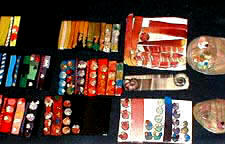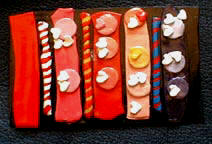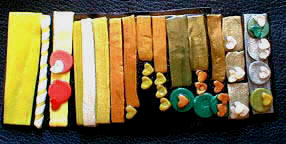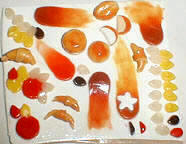I found that the way to record
color mixes and store them in as small a space as possible is to keep
the records small.
http://www.norajean.com/Biz-Archive/ColorCards/MainGroup.htm

For example: Each color card is the size of a playing card and many can
be stored in one mint tin. Each color card record is a series of thin
ribbons, small circles cut out of thin ribbon, smaller stars or hearts
also cut out of thin ribbon.
http://www.norajean.com/Biz-Archive/ColorCards/Samples/Card-002.htm
 Let's
look at this color card as an example. Let's
look at this color card as an example.
Starting from the left I have a ribbon pressed very thin of the cadmium
red straight out of the pack. To the left of the red ribbon are
two snakes of clay, red and white, twisted together. Below the two
snake twist is the result of that red and white mix, seen as a ribbon
pressed thin.
On top of that half red and half white mix ribbon are circles with white
hearts and this represents red with two parts white, red with three
parts white, and the mix of additional white are the circles.
Next to that is a two snake ribbon of red and yellow.
Next to that is the half red half yellow mix as a ribbon pressed thin.
The circles on top of the half red and half yellow ribbon show what that
mix looks like with one portion of white, two portions of white, and a
portion of pink and that's how I discovered the color peach.
The next ribbon shows the red and yellow mix with more white and more
yellow.
Then we have the red and blue two snake twist. You can hardly tell that
the purple ribbon is on the black color card it's so dark. The circles
on top of that ribbon shows that purple mix with more and more portions
of white.
That one card is small enough to fit in the palm of your hand because
you don't need a lot of clay to record the mixes. You just need a small
amount to make a record.
Keeping a record of the color mixes like this is very liberating
actually. There are mixes that can be used for mini fruit and for faux
gems. Like the mix for key lime pie can be used for making faux jade.
By recording the color cards in color families you can refer to one card
over and over depending on what color mix you're needing to make.
There are color combinations you might not have thought of making if you
didn't fall over them by doing these color exercises.
Using metal colors with the primary and secondary colors are my favorite
discoveries.
http://www.norajean.com/Biz-Archive/ColorCards/Samples/Card-004.htm

The colors at the far right of that card are my
favorites, mixing gold with green has become one of my most loved color
mixes.
 There
are times when I'm trying to rediscover a mix I made in the past and I
didn't take time to record my steps, like rediscovering melted cheddar
cheese that I use for toasty top on mini bread.
http://www.norajean.com/Food/ToastyTop/Card.htm There
are times when I'm trying to rediscover a mix I made in the past and I
didn't take time to record my steps, like rediscovering melted cheddar
cheese that I use for toasty top on mini bread.
http://www.norajean.com/Food/ToastyTop/Card.htm
This card has the different mixes I tried to
recreate something I mixed by accident. In the process of seeking out
the melted cheddar cheese mix I discovered pumpkin pie, dark mustard,
and other colors that might come in handy in the future. No mix is a
failure, it's a discovery that you don't have use for at the present
time.
Keep track of the colors you mix in small thin shapes and slap them on
already cured color cards that are waiting to be filled.
As for storage I have all the color cards in a plastic container set on
their side. I can flip through them like index cards in a bin. They
don't take up a lot of space because I don't use a lot of clay to make
them.
I've seen some other color mix recording systems and they all share one
disadvantage, they are too big and take up too much space. Using a one
inch square of one color mix doesn't seem like a lot of clay or space,
but look at how many color mixes you can put on a color card using
ribbons, circles, and hearts. That card is 2 inch by 4 inch, roughly and
there are 15 color mixes on the first card I shared with you.
The color cards also show you a progression from the primary color of
red, yellow or blue, and how the secondary colors come from mixing
those, how pastels come from adding white, how these primary and
secondary colors look like if we added metallic colors to them. There's
a progression and it's very compact.
|


